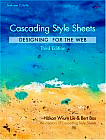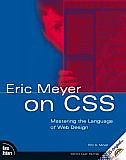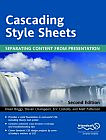Cascading Style Sheets ::CSS Ressourcen
Buchvorstellungen
Nur deutsche Buchvorstellungen ansehen
Nur englische Buchvorstellungen ansehen
Die hier vorgestellten Bücher sind eine unvollständige Auswahl der am Markt verfügbaren Ausgaben und wurden hier nach verschiedenen Gesichtspunkten, wie Aktualität, Reputation der Autoren oder Amazon-Bewertung, aufgenommen. Die Bücher sind nach Ausgabedatum geordnet.
Wer englischsprachige Bücher vorzieht, sollte sich überlegen, bei Amazon.COM zu bestellen, da sie dort einschließlich der Versandkosten erheblich günstiger zu beziehen sind. Die ungefähren US-Preise sind, umgerechnet in Euro, bei den englischen Büchern angegeben.
| Sprache: | English |
| Amazon-Bewertung: | — |
| Ausgabe: | März 2005 |
| Preis: | EUR 34,90 |
| Preis Amazon(US): ca. | EUR 23,00 |

Cascading Style Sheets:
Designing for the Web
Direct from the creators of CSS, this is the definitive reference to CSS 2.1, today's indispensable standard for controlling the appearance of any Web or XML document. This full-color book doesn't just show how to use every significant CSS 1 and 2.x feature; it carefully explains the "why" behind today's most valuable CSS design techniques. You'll find practical, downloadable examples throughout — along with essential browser support information and best practices for building high-impact pages and applications.
Bert Bos was, in 1994, one of the original authors of CSS, together with Håkon. He joined W3C in 1995 to set up W3C's Internationalization activity, and, of course, to work on style sheets. He is now the coordinator for W3C's style sheet activities. He studied mathematics in Groningen, the Netherlands and holds a PhD from that university. He once wrote a Web browser and is very interested in the Semantic Web.
Håkon Wium Lie proposed the concept of CSS in 1994 and, as a W3C staff member, worked with Bert to write the CSS specifications. Håkon is now the CTO of Opera Software where his job is to make sure the Opera browser works better than the one you know. Håkon holds an M.S. degree from the MIT Media Laboratory. He likes to fly kites and repair vacuum cleaners.
TOP
| Sprache: | English |
| Amazon-Bewertung: | — |
| Ausgabe: | Februar 2005 |
| Preis: | EUR 47,90 |
| Preis Amazon(US): ca. | EUR 20,40 |
Proving once and for all that standards-compliant design does not equal dull design, this inspiring tome uses examples from the landmark CSS Zen Garden site as the foundation for discussions on how to create beautiful, progressive CSS-based Web sites. By using the Zen Garden sites as examples of how CSS design techniques and approaches can be applied to specific Web challenges, authors Dave Shea and Molly Holzschlag provide an eye-opening look at the range of design methods made possible by CSS (Cascading Style Sheets). By the time you've finished perusing the volume, you'll have a new understanding of the graphically rich, fully accessible sites that CSS design facilitates. In sections on design, layout, imagery, typography, effects, and themes, Dave and Molly take you through every phase of the design process--from striking a sensible balance between text and graphics to creating eye-popping special effects (no scripting required).
TOP
| Sprache: | Deutsch |
| Amazon-Bewertung: | |
| Ausgabe: | Januar 2005 |
| Preis: | EUR 8,90 |

Dieses Buch ist eine Neuauflage der inzwischen vergriffenen Ausgabe von 2001 (auf die sich auch die Amazon-Bewertung bezieht). Es ist kein Lehrbuch, sondern Nachschlagewerk und Referenz für alle, die schon etwas mit CSS anzufangen wissen. Kern dieser Ausgabe ist eine vollständige Referenz aller CSS-Eigenschaften, die in den Standards CSS2 und CSS2.1 definiert sind. Eric Meyer, international anerkannter Webstandards- und CSS-Experte, gibt darüber hinaus eine kurze Einführung in die Funktionsweise und grundlegenden Konzepte von Cascading Style Sheets.
TOP
| Sprache: | Deutsch |
| Amazon-Bewertung: | |
| Ausgabe: | Januar 2005 |
| Preis: | EUR 34,90 |
[...] Als Orientierungshilfe gibt der Autor darüber hinaus für jedes Element an, welche Probleme und Einschränkungen bei der Verwendung mit unterschiedlichen Browsern auftreten können. Im sechsten Abschnitt werden typische Probleme bei der CSS-Anwendung einschließlich ihrer Lösung dargestellt. Abschließend lernt man anhand beispielhafter Websites wichtige Software-Werkzeuge kennen. Zusätzlich findet sich im Anhang des Buchs eine Stylesheet-Kompatibillitätstabelle zum Herausnehmen. Die beiliegende CD-ROM beinhaltet alle Beispiele und Abbildungen des Buchs, alle besprochenen Skripte sowie Freeware, Shareware und Demoversionen.
TOP
| Sprache: | Deutsch |
| Amazon-Bewertung: | |
| Ausgabe: | Dezember 2004 |
| Originalausgabe: | Juni 2002 |
| Preis: | EUR 44,95 |
| Preis Amazon(US): ca. | EUR 24,20 |

Meyer zeigt die Verwendung von Cascading Style Sheets anhand von 13 praxisbezogenen Projekten. Die Projekte sind sorgfältig zusammengestellt und ihre Lösungen browserübergreifend kompatibel. Wer die Aufgaben selbst durcharbeiten möchte, findet alle nötigen Dateien auf der Website zum Buch. Themen sind unter anderem:
- Konvertierung einer existierenden HTML-Seite nach CSS
- Formatierung eines Veranstaltungskalenders
- Gestaltung eines Input-Formulars
- Anbringen von Hintergrundelementen
- Kreation von nicht-rechteckigen Layouteffekten
Es gibt eine Reihe anderer Bücher auf dem Markt, die als tiefergehende technische Hilfe oder Referenzbücher für CSS dienen können. Bis heute ist jedoch keins mehr praxisorientiert und verwendet mehr praktische Beispiele wie dieses, um dem Leser die Lösungen für seine CSS-Probleme aufzuzeigen.Das Buch wendet sich vor allem an Leser, die mit den Grundlagen des CSS bereits vertraut sind und setzt auch gute HTML-Kenntnisse voraus.
TOP
| Sprache: | Deutsch |
| Amazon-Bewertung: | |
| Ausgabe: | November 2004 |
| Preis: | EUR 39,00 |
CSS ist die vom W3C anerkannte Methode, um die visuelle Darstellung von Webdokumenten über die kruden Möglichkeiten von HTML und XHTML hinaus zu beeinflussen und zu vereinfachen. Mit übersichtlichen und leicht zu wartenden Stildefinitionen ist es möglich, ausgefeilte Seitenlayouts für eine ganze Website zu erstellen und bei Bedarf in kürzester Zeit zu verändern. Außerdem können mit CSS Inhalte und Layout von Webdokumenten separat entwickelt werden.
Eric A. Meyer, ein international anerkannter Experte auf den Gebieten HTML, CSS und Webstandards, behandelt in diesem Buch ausführlich die aktuellen Standards CSS2 und CSS2.1. Detailliert beschreibt er alle CSS-Eigenschaften, erläutert, wie sie mit anderen Eigenschaften zusammenwirken und zeigt anhand vieler praktischer Beispiele, wie sie angewendet werden. Zu den behandelten Themen gehören:
- Selektoren, Pseudoklassen und Pseudoelemente
- Struktur und Kaskadierung
- Werte und Einheiten
- Textformatierung und Schriften
- Block- und Inline-Elemente
- Elementbox, Rahmen, Innen- und Außenabstände
- Farben und Hintergründe
- Positionierung und Floats
- Tabellen, Listen und generierter Inhalt
Mit einem Vorwort von Molly Holzschlag, Vorstandsmitglied des Web Standards Project.
TOP
| Sprache: | English |
| Amazon-Bewertung: | |
| Ausgabe: | August 2004 |
| Preis: | EUR 8,99 |
An indispensable reference for web designers and developers, this slim little book covers the essential information needed to effectively implement CSS, with an introduction to the key concepts of CSS and a complete alphabetical reference to the CSS2 and CSS 2.1 properties. And since browser incompatibility is the biggest CSS headache for most developers, it also includes an invaluable chart displaying detailed information about CSS support for every style element across all browsers. For anyone who wants to correctly implement CSS, this book condenses all the details in its companion volume, Cascading Style Sheets: The Definitive Guide, into one easy-to-use cheat-sheet. The CSS Pocket Reference delivers just the CSS details that you need to complete the task at hand. When you're stuck and want an answer quickly, the tiny CSS Pocket Reference is the book you'll want by your keyboard or in your back pocket.
TOP
| Sprache: | English |
| Amazon-Bewertung: | |
| Ausgabe: | April 2004 |
| Preis: | EUR 38,90 |
| Preis Amazon(US): ca. | EUR 24,40 |
More Eric Meyer on CSS
More Eric Meyer on CSS picks up where the original book ended, going into detail on a score of important Web-design tasks. As he did with his first book, Meyer has had this one laid out in a broad-page format, with many illustrations, and printed in full color. The net effect is that readers see the design effects of the CSS tweaks under discussion, and there's no way to imagine (or load code) to see how colors and shadings look when rendered in a browser.
Appealingly, this book is oriented around typical design projects (such as annual financial reports, weblogs, and personal homepages) and widely used design features (including menus and index tabs). This structure ensures the utility of Meyer's book —you can just turn to the chapter that deals with whatever you're trying to build, and see what the author did in a similar situation. Each section involves far more prose than code; Meyer is very careful to spend more time explaining what he's doing than he spends actually doing it, and the reader is never overwhelmed by giant CSS listings. Numerous screen shots intersperse the code and commentary, allowing you to see the intermediate results of style sheets in progress and adapt Meyer's beginnings in order to achieve different ends.
TOP
| Sprache: | English |
| Amazon-Bewertung: | |
| Ausgabe: | März 2004 |
| Preis: | EUR 39,54 |
| Preis Amazon(US): ca. | EUR 21,00 |

This book is a focused guide to using Cascading Style Sheets (CSS) for the visual design of web pages. It provides concise coverage of all the essential CSS concepts developers need to learn (such as separating content from presentation, block and inline elements, inheritance and cascade, the box model, typography, etc). It also covers the syntax needed to effectively use CSS with your markup document (for example CSS rules, how to structure a style sheet, linking style sheets to your (X)HTML documents, CSS boxes etc). CSS (Cascading Style Sheets) is a powerful technology that can be used to add style and structure to your web pages without needing to resort to "hacks" such as HTML table layouts and "spacer images". However, this is not the only advantage over other styling methods. You can specify your CSS styles in a separate file, then apply those styles to every page in your web site. When you want to change a style on your site, you can do it by modifying one style sheet, rather having to update every page. This is only one example of the many advantages CSS brings to your web development work.
TOP
| Sprache: | English |
| Amazon-Bewertung: | |
| Ausgabe: | März 2004 |
| Preis: | EUR 34,50 |
| Preis Amazon(US): ca. | EUR 20,40 |
Cascading Style Sheets: The Definitive Guide is a comprehensive text that shows you how to take advantage of the benefits of CSS while keeping compatibility issues in mind.
The book is very upfront about the spotty early browser support for CSS and the sluggish adoption of CSS2. However, enthusiasm for the technology spills out of the pages, convincing even the most sceptical reader to give CSS a whirl and count on its future. CSS1 is covered in impressive depth, not only the syntactical conventions but also more general concepts such as specificity and inheritance. Frequent warnings and tips alert the reader to browser compatibility pitfalls.
Entire chapters are devoted to topics such as units and values; visual formatting and positioning; and the usual text, fonts and colours. This attention to both detail and architecture helps readers build a well-rounded knowledge of CSS and equips them for a future of real-world debugging. Cascading Style Sheets honestly states its reasons for avoiding an in-depth discussion of the still immature CSS2, but covers the general changes over CSS1 in a brief chapter near the end of the book.
When successfully implemented, Cascading Style Sheets result in more elegant HTML that separates form from function. This fine guide delivers on its promise as an indispensable tool for CSS coders.
TOP
| Sprache: | Deutsch |
| Amazon-Bewertung: | |
| Ausgabe: | Oktober 2003 |
| Preis: | EUR 32,90 |
Shafer sieht CSS nicht, wie leider immer noch allzu viele Designer, lediglich als Anhübscher von HTML. Er erklärt umfassend die wirklichen Neuerungen in der Webprogrammierung. Für das Design eigener Seiten wird man somit ganz an den Anfang zurückgeführt. Schon die technische Konzeption, wie etwa die HTML-Dokumentenstruktur, sollte auf CSS eingestellt werden.
Nach der Schilderung des Einsatzzweckes und Grundlagen von externer Einbindung, Syntax, Box-Modell und Kaskadierung zeichnet Shafer den ganzen Prozess der Website-Programmierung neu auf. Er geht dafür den zwar unorthodoxen, aber umso gründlicheren Weg vom Lay-out mit CSS, dass HTML-Tabellen nahezu überflüssig macht, hin zu den Details in Text- und Bildgestaltung. Das, was man also von CSS schon so kennt, kommt erst ganz am Schluss. Davor gibt es richtig was zu lernen!
Nicht weniger erfreulich ist Shafers Erklärungsweise ganz hart an der Praxis: Beispiele ziehen sich über mehrere Seiten und werden in allen Fassetten ausführlich erklärt, nicht ohne die größten Klippen von CSS, der abweichenden Interpretation in unterschiedlichen Browser-Versionen, konsequent zu umschiffen. Die Source Codes und passenden Screenshots werden gleich anbei geliefert, alles ist im Workshop-Charakter einfach nachvollzieh- und nachprogrammierbar.
TOP
